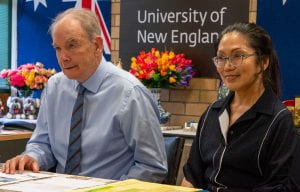High school students in South Korea have had their first virtual lesson on the intricacies of nuclear science delivered by Dr Bridget Murphy from the Australian Nuclear Science and Technology Organisation (ANSTO) this month.
The initiative is part of a bigger project to establish the ANSTO nuclear science education program in South Korea. Entitled ‘ANSTO and Korea’ the project is funded by the Australian Department of Foreign Affairs and Trade’s 2021 Australia-Korea Foundation grant and facilitated by the University of New England’s Asia ConneXions team led by Dr Myung-Sook Auh.
“We’ll be using UNE’s digital technology to connec t educators from ANSTO with Korean universities and schools via videoconferencing as well as organising a nuclear science project competition as a hands-on activity,” Dr Auh said.
t educators from ANSTO with Korean universities and schools via videoconferencing as well as organising a nuclear science project competition as a hands-on activity,” Dr Auh said.
“South Korea students are very interested in learning about nuclear science and this project provides them with the opportunity to do so.
“This year will be the first time that UNE introduces ANSTO’s nuclear science education to South Korean universities aiming at pre-service teachers and teacher educators.”
ANSTO operates one of the world’s most modern nuclear reactors, OPAL, and Education Manager Dr Bridget Murphy said that they are very excited to be part of this project and to be able to engage directly with the students using the technology provided by UNE.
“There is often a lot of misinformation, unnecessary fear and distrust about nuclear science. This project helps build relationships with the next generation of informed global citizens, so they can understand the role of nuclear science in improving human health and the environment,“ Dr Murphy said.
During the first lesson the students watched a video on nuclear fission and virtually participated in experiments to determine what material offered the best radiation protection. Korean students learned how ANSTO works safely with radiation, shielding the core of the reactor with water and transporting nuclear medicines in lead-lined containers.
When asked why they chose to take part in the ANSTO program student feedback included:
“From the ANSTO session, I got opportunities to study further about nuclear fission and the way the reactor in ANSTO generates neutrons for nuclear medicines. And I learned how much the lead and water shield radiation.”
And “Last year, I studied nu clear science, especially about nuclear fission, in school science classes. I was told that there are a variety of structures of nuclear fission power generation, but I only had an opportunity to learn one representative structure of it. I did not have a chance to learn about the principles and components in detail. That is why I chose the ANSTO topic with the hope to extend my knowledge and understanding about nuclear science.”
“Using technology to build people-to-people connections is one of DFAT’s primary deliverables, and using advanced technology to further STEM education is in line with UNE’s newly launched strategic plan, Future Fit,” Dr Auh said.
“The project supports knowledge sharing but also allows UNE, ANSTO and the South Korean students to learn about one another’s culture and language while building enduring networks.
For further information please contact Dr Myung_Sook Auh, School of Education and the SiMERR National Research Centre on mauh@une.edu.au or +61 (0)2 6773 2917


Recent Comments